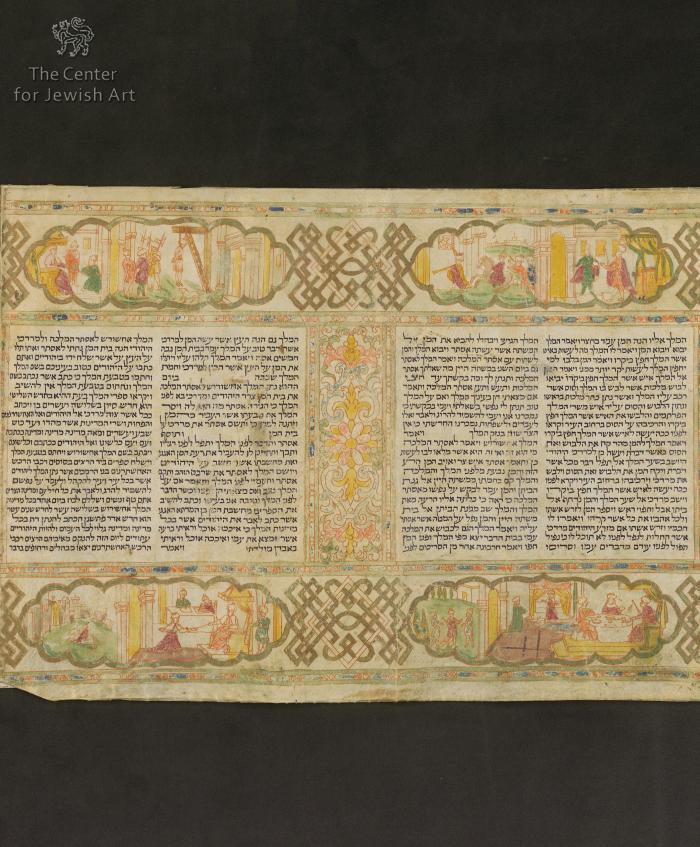Img. ID: 341466

Cartouche 11 (upper margin): On the right, Ahasuerus stands next to his throne and points at Haman who stands before him while they are talking (Es. 6:6-10). On the left, Mordecai rides a horse followed by two men and Haman walks before him while blowing a trumpet (Es. 6:11). The scene of the triumph of Mordecai is supplemented by the depiction of Haman's daughter who, from a window above, empties a chamber pot on her father's head (Megillah 16a).
Cartouche 12 (lower margin): On the right, the second banquet given by Esther is shown (Es. 7:1). The queen sits at a round laid table and is accompanied by Ahasuerus (who sits on the canopied throne) and Haman (who sits between them). In the central part of the cartouche, Haman is begging for his life and is prostrated on the floor before Esther while Ahasuerus is returning from the palace gardens (Es. 7:7-8). On the left, Ahasuerus stands in the palace garden with a scepter in his hand, accompanied by two chamberlains; one of them may be Harbonah, who suggests hanging Haman on the gallows he had prepared for Mordecai (Es. 7:9).
Cartouche 13 (upper margin): On the right, Haman is hanged on the gallows (Es. 7:10). A ladder leans against it and three guards, holding spears, stand on the left. At Haman's feet, there is a dog that is looking up at him. On the left, Ahasuerus sits on the canopied throne and extends his scepter to Esther, who kneels at his feet and touches the tip of the scepter. Mordecai stands in the background and watches the scene (Es. 8:1-4). This either depicts the moment when the king gives Haman's properties to Esther (Es. 8:1) or when Esther is pleading to annul Haman's decree (Es. 8:3-4).
Cartouche 14 (lower margin): On the right, Ahasuerus sits on a throne under a canopy and extends the scepter to Esther, who kneels at his feet and touches the tip of the scepter. Behind the throne stands a man (possibly Mordecai) and in the background, two king's scribes sit at a table and write the king's decree (Es. 8:9). On the left, two mounted messengers ride towards a walled city on the far left (Es. 8:14).
The length of the sheets in the scroll: 1) 525 mm, 2) 515 mm, 3) 535 mm.
Dimensions of the selected details in the scroll:
- upper and lower margins: 42 mm;
- endless knot pattern: 32x42 mm;
- cartouche with a narrative scene(s): 28x910 mm (inside);
- text panel: 81x102 mm;
- text column: 73x47 mm;
- space between text columns: 4 mm;
- margins around the text column: 5-6 mm;
- an average letter: 2 mm;
- letters in the Haman's sons section: 4 mm.
The roller: 280 mm.
O | Ornamentation: | Endless knot
O | Ornamentation: | Cartouche
O | Ornamentation: | Foliate and floral ornaments
E | Esther, Book of (following the order of the story) | Mordecai's triumph (Es. 6:11)
E | Esther, Book of (following the order of the story) | Haman's daughter empties a chamber pot on her father's head (Bab. Talmud, Megillah 16a)
E | Esther, Book of (following the order of the story) | Esther's second banquet (Es. 7:1)
E | Esther, Book of (following the order of the story) | Ahasuerus returns from the palace garden (Es. 7:8)
E | Esther, Book of (following the order of the story) | Haman begging for his life (Es. 7:8)
E | Esther, Book of (following the order of the story) | Harbona suggests to hang Haman (Es. 7:9)
E | Esther, Book of (following the order of the story) | Ahasuerus asks Haman how to honour a man he wishes to reward (Es. 6:5-10)
E | Esther, Book of (following the order of the story) | Haman hanged (Es. 7:10)
E | Esther, Book of (following the order of the story) | Ahasuerus giving Esther the house of Haman (Es. 8:1)
E | Esther, Book of (following the order of the story) | Esther at Ahasuerus' feet, pleading he annuls Haman's decree (Es. 8:3)
E | Esther, Book of (following the order of the story) | Ahasuerus extending his scepter to Esther (Es. 8:4)
E | Esther, Book of (following the order of the story) | Ahasuerus' messenger(s) (Es. 8:14)
|
The state of preservation of the subsequent sheets differs.
In general, the decoration of the second membrane is preserved in worse condition than on the first one.
The text in the scroll is well preserved.
The second and third sheets are stitched very loosely.
The blue paint is very poorly preserved.
The sheets are stained in several places.
The Book of Esther in Hebrew
The scroll is formed of 3 sheets containing 19 columns of the text with 22 or 23 lines, except for col. 16 with 11 lines divided into two parts.
The number of text columns per sheet: sheet no. 1 - 6, no. 2 - 8, no. 3 - 5.
The text is inscribed in a Hebrew square Italian script, in intense black and slightly shiny ink, on the flesh side of parchment sheets which are bright and matte - though their other side is more yellow and smooth.
On the 3rd membrane, a double layer of ink is visible on the letters.
The letter ח (Es. 1:6) is slightly larger than an average letter in the scroll. The letter ת (Es. 9:29) is also enlarged; it is 3 mm high. Other enlarged and diminished letters are included in col. 16.
The word ויעש written in brown ink and in a different hand-writing is added in col. 10 (on the floral ornament). Several lines below, one more word - המלך - was added.
The left margins of several columns are not straight.
The ruling made with a stylus is slightly visible.
The pricking can be discerned on the blank side of the scroll.
None
The name "Gaster I" was introduced by Mendel Metzger in his article entitled "The Earliest Engraved Italian Megilloth" (see "Bibliography"). The type was named after Moses Gaster (1856–1939), the rabbi, scholar, and manuscript collector, who owned a scroll adorned with this pattern (at present this is the scroll Gaster Hebrew MS 710 stored in the John Rylands Library in Manchester - ID 36150). At least 25 manuscripts representing this type are still extant and are preserved in private and institutional collections. For their descriptions see "Related objects".
The pattern features a number of decorative elements common with the scrolls of Klagsbald type.
On the blank side of the opening section of the scroll, there is an inscription in the Latin alphabet: "Liber Ester Hebraice".
Eye-catching yellow details that are especially well visible on the 2nd sheet are the characteristic feature of this scroll.
Originally the endless knot patterns and cartouches' frames were painted gold but only some remains of the color are still visible; at present these details are rather green.
The right edge of the first sheet is trimmed into a multifoil.
The first sheet differs from the remaining two membranes; the border on it is printed in black ink and the text is written in 23 lines.
The manuscript has been stored in the library at least since the 1840s. It is listed by Bartolomeo Secco Suardo in "Catalogo generale della pubblica Biblioteca comunale della regia Città di Bergamo" that was written in 1840.
Bibliography concerning the scroll from the Mai Library:
Panoramic image of recto and verso sides of the manuscript available on the website of Biblioteca Digitale Lombarda: https://www.bdl.servizirl.it/bdl/bookreader/index.html?path=fe&cdOggetto=6002#mode/1up (accessed on 29.09.2020).
Detailed description in Italian and images available on https://www.effettobibbia.it/il-rotolo-di-ester (accessed on 29.09.2020).
Selected bibliography concerning other scrolls decorated with the same border:
Mendel Metzger, The Earliest Engraved Italian Megilloth, Bulletin of the John Rylands Library 1966, 48/2, 381–432.
Cornelia Bodea, Treasures of Jewish Art. The 1673 Illuminated Scroll of Esther Offered to a Romanian Hierarch, Iaşi–Oxford–Palm Beach–Portland 2002.
A Journey through Jewish Worlds: Highlights from the Braginsky Collection of Hebrew Manuscripts and Printed Books, eds. Evelyn M. Cohen, Emile Schrijver, Sharon Liberman Mintz, Amsterdam 2009, 240-241.
Schöne Seiten. Jüdische Schriftkultur aus der Braginsky Collection, eds. Emile Schrijver, Falk Wiesemann, Evelyn M. Cohen, Sharon Liberman Mintz, Menahem Schmeltzer, Zurich 2011, 262-263.
Dagmara Budzioch, The Decorated Esther Scrolls from the Museum of the Jewish Historical Institute in Warsaw and the Tradition of Megillot Esther Decoration in the Seventeenth and Eighteenth Centuries – An Outline [Polish: Dekorowane zwoje Estery z Żydowskiego Instytutu Historycznego w Warszawie na tle tradycji dekorowania megilot Ester w XVII i XVIII wieku. Zarys problematyki], Warsaw 2019, 1:99-119, 2:64-69.
Dagmara Budzioch, "An Illustrated Scroll of Esther from the Collection of the Jewish Historical Institute as an Example of the Gaster I Megilloth," Kwartalnik Historii Żydów 2013, no. 3 (247), 533–547.



